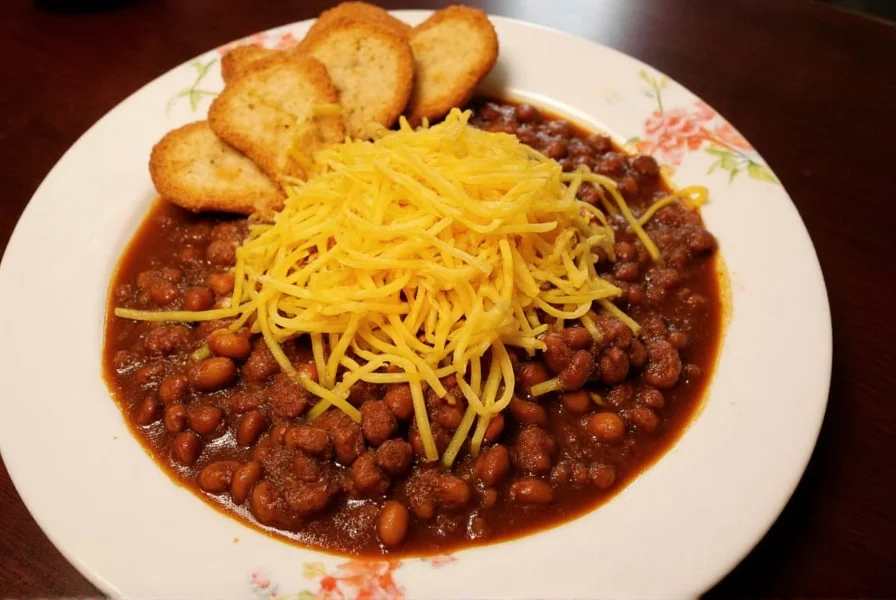Discover the authentic taste of the Midwest with this comprehensive guide to Cincinnati-style chili. Unlike conventional chili recipes, Cincinnati chili features a distinctive blend of warm spices that create a complex flavor profile unlike anything you've tasted. This regional specialty has been a Cincinnati staple since the 1920s when Macedonian immigrants first introduced it to the area.
What Makes Cincinnati Chili Different
Cincinnati chili stands apart from traditional chili con carne in several key ways. While most chili recipes focus on bold, spicy flavors with generous amounts of chili powder and cumin, Cincinnati chili incorporates unexpected spices like cinnamon, allspice, and sometimes even chocolate or cocoa powder. The texture is thinner than conventional chili, more like a meat sauce than a hearty stew.
The most distinctive characteristic is how it's served. Rather than being a standalone dish, authentic Cincinnati chili is always served as a topping for spaghetti, creating what locals call a "3-way." Add cheese for a "4-way," or include beans and onions for a "5-way." This unique serving method reflects the dish's immigrant roots and adaptation to local tastes.
A Brief History of Cincinnati Chili
Cincinnati chili was created in the 1920s by Macedonian immigrants Tom and John Kiradjieff. Their restaurant, Empress Chili, opened in 1922 and established the foundation for what would become a Cincinnati institution. The Kiradjieff brothers adapted their traditional Mediterranean meat sauce recipes using locally available ingredients, resulting in the distinctive spice profile that defines Cincinnati chili today.
Unlike Texas-style chili which emphasizes meat and heat, or New Mexico chili focused on roasted peppers, Cincinnati chili represents a fascinating culinary fusion that has endured for nearly a century. Today, dozens of chili parlors operate throughout the Cincinnati area, each with slight variations on the original recipe.
Essential Ingredients for Authentic Cincinnati Chili
The magic of Cincinnati-style chili comes from its unique spice blend. Here's what you'll need for an authentic recipe:
| Ingredient | Amount | Why It Matters |
|---|---|---|
| Ground beef (80/20) | 2 lbs | Provides rich flavor and proper texture |
| Tomato paste | 1/2 cup | Adds depth without making it too acidic |
| Worcestershire sauce | 2 tbsp | Enhances umami flavor profile |
| Cinnamon | 1 tsp | Signature warm note in authentic recipes |
| Allspice | 1 tsp | Creates complex spice foundation |
| Cocoa powder | 1 tbsp | Adds richness and depth (not sweetness) |
Unlike conventional chili recipes, Cincinnati-style chili uses finely ground beef rather than chunks. The meat should be almost paste-like in consistency after cooking, which helps it adhere properly to spaghetti.

Step-by-Step Cincinnati Chili Recipe
Follow these steps for an authentic Cincinnati chili experience:
- Brown 2 pounds of ground beef in a large pot, breaking it into very fine pieces
- Add 1 chopped onion and cook until translucent
- Stir in 1/2 cup tomato paste and cook for 2 minutes
- Add 4 cups of water or beef broth
- Mix in 2 tablespoons Worcestershire sauce
- Add spices: 1 teaspoon each cinnamon, allspice, and chili powder; 1/2 teaspoon cloves; 1 tablespoon cocoa powder
- Simmer uncovered for 2-3 hours, stirring occasionally
- Add salt to taste during the last 30 minutes of cooking
The long simmering time is crucial—it allows the flavors to meld and the sauce to develop its characteristic thin but flavorful consistency. Unlike traditional chili, Cincinnati chili shouldn't be thick; it needs to coat spaghetti properly.
Serving Cincinnati Chili the Traditional Way
Cincinnati chili has its own unique terminology for how it's served:
- 3-way: Spaghetti topped with chili
- 4-way: Spaghetti with chili plus either cheese, beans, or onions
- 5-way: Spaghetti with chili plus two additional toppings (typically cheese and beans)
The most popular preparation is spaghetti topped with chili and a generous amount of shredded cheddar cheese (a 4-way). Many locals consider the cheese essential, as it melts into the hot chili creating a rich, creamy texture that balances the spices.
Common Mistakes to Avoid
When making Cincinnati chili recipes, watch out for these common pitfalls:
- Using chunky beef: Authentic recipes use finely ground meat that almost dissolves into the sauce
- Skipping the long simmer: The flavors need time to develop properly—don't rush the cooking process
- Overdoing the heat: Cincinnati chili isn't meant to be spicy hot; the focus is on complex spice notes
- Serving it like regular chili: Remember it's a topping, not a standalone bowl of chili
- Using pre-made spice mixes: The specific balance of spices is crucial to authentic flavor
Variations and Adaptations
While traditional Cincinnati chili follows a specific formula, home cooks have developed several variations:
- Vegan Cincinnati chili: Substitute textured vegetable protein for beef and use vegan Worcestershire
- Gluten-free version: Ensure your Worcestershire sauce is gluten-free (many contain barley)
- Slow cooker method: Brown meat first, then transfer to slow cooker for 6-8 hours on low
- Instant Pot adaptation: Use sauté function for browning, then pressure cook for 30 minutes
For those seeking the most authentic cincinnati chili spices ingredients experience, stick to the traditional recipe without major substitutions. The unique flavor profile depends on the precise balance of ingredients.
Storage and Reheating Tips
Cincinnati chili actually tastes better the next day as the flavors continue to meld. Store leftovers in an airtight container in the refrigerator for up to 5 days or freeze for up to 3 months.
When reheating, add a small amount of water or broth to restore the proper consistency. The sauce will thicken when chilled, so thinning it slightly creates the ideal texture for topping spaghetti. Gently reheat on the stove over medium-low heat, stirring occasionally.











 浙公网安备
33010002000092号
浙公网安备
33010002000092号 浙B2-20120091-4
浙B2-20120091-4